You're headed out to the chicken coop, ho-hum, just as you would any other day. As you catch sight of your flock, something is wrong. One of your birds is missing a large portion of feathers and skin. The coop is dirty, chicken poop is everywhere, and the injured chicken may already have dirt and crud burying the wound bed. How do you care for a chicken's wounds?
Chickens can get wounds for any variety of reasons, and I imagine you are facing an emergency. The purpose of this article is to advise you on how to clean and bandage a recent, non-infected laceration or superficial wound. I strongly recommend fixing or removing the source of the injury as soon as your chicken is in a safe environment; but I will not be advising about that in this article. Also, I am not a veterinarian, and my experience with poultry is limited to about three years; all information given here is strictly from my experiences and the amazing advise given from other veteran poultry hobbyists on BYC. If you have a veterinarian on hand or your bird appears to have an infection (greenish color, pus, redness, smelly wound, warmth around the wound), or any other major emergency (and you realllllly want this bird to live) GO TO A VET ASAP.
Before we get into it... understand that your chicken will act differently when they are injured. In severe pain, or following a traumatic event, they may exhibit any of the following: closed eyes, dilated or dark eyes, slow movement, sparing the injured body part, drooping their wings, pecking at the injury, pecking others or showing aggressive behavior, being extremely skittish or hiding, or "running away" and keeping a wide berth from anybody else. Their feathers might be poofed out, they will keep their heads very close to their bodies, and they might appear to be taking a nap while standing. With head injuries, even if it is only to the skin, they often have seizures and will shake, or they might shake the injured body part. These are normal chicken reactions to pain and/or illness. One of my cockerels would do barrel-rolls trying to escape his wing-pain. Every bird has their own personality and will react differently. Typically these signs will only stop once the bird is no longer experiencing pain or discomfort; expect them to continue until they are almost healed.

My cockerel Raptor- in MUCH pain, right before he started doing barrel-rolls.
FIRST: SEPARATE-PREPARE
Separate your bird. Place them in a covered box, covered laundry basket, or pet carrier, while you gather supplies and assess the scenario. Personally, my chickens will not move if they are set inside a laundry basket with a towel covering the top; this is only temporary.
Gather your first aide supplies. These are recommended in the Chicken First Aide Kits- Handy and Essential Supplies and How to Use Them article on BYC by pipdzipdnreadytogo: vinyl gloves, rubbing alcohol, hydrogen peroxide, chlorhexidine or povidone iodine (Betadine) solution, triple antibiotic ointment or neosporin (bacitracin), Vetericyn spray, non-stick pads or gauze, waterproof tape, self-adhering first aid wrap (VetWrap), vitamin/electrolyte water boost (Sav-a-chick), Q tips, scissors, flash light, old (clean!) towels, bleed-stop/styptic powder (baking soda or corn starch), scalpels, and tweezers. If you don't have all of these, don't worry, you may not need them and there are plenty of substitutes (I'll mention these later on).

My original first aide supplies
Some people think their bird needs pain relief; crushed aspirin is often utilized for pets, but remember, it is a blood thinner. For a skin wound or laceration, I don't recommend anything. Most spray-on or ointment painkillers are in the form of lidocaine, benzocaine, or something-ocaine, which is a chicken killer. These ingredients, although they provide pain relief, are extremely toxic to chickens. When I first started with chickens, I used Band-Aide Hurt-Free Antiseptic Wash without any problems, and only in an emergency situation. In the event that you do use a painkiller, keep in mind that you might be doing more harm than good. Chickens are much tougher than you might think. If there is no obvious bleeding or vessel involvement, 81grams of baby aspirin is good for an adult, average sized chicken every 12hours. If they have not improved at all after the first 72hours of cleaning/care, they probably have an underlying infection, and need veterinary assistance (antibiotics).
Also, from personal experience, I highly recommend having a cover for your birds eyes (if it is not a head wound). I used the tube of a long sock, and cut off the foot end, then placed it over the head to cover the eyes. It will make the process immensely easier, and being placed in the dark will calm most injured animals. You can achieve the same thing with stockinette, which doubles as an amazing bandage (pics further down). If you have stockinette, add it to your chicken first aide, as it is extremely useful.
SECOND: MAKE A HOSPITAL AREA
This can be a table top, the floor, or even a bathtub. Your bird may flap their wings or attempt to escape, so choose an area that is stable and they can easily be recollected. The scenario will also be messy, so pick someplace that is easy to clean up after, or that can be stained without issue (iodine, blood, and blukote spray are likely to go everywhere). I recommend putting down old towels as your "hospital table" so that your bird won't lose their footing, and the mess can easily be cleaned up (ie if the patient poops). Have extra towels handy in case you need a fresh floor.
Ensure that all of your scissors, syringes, tweezers, spray bottles, or anything else that might touch the patient or the wound is sterile. Clean them with rubbing alcohol or wash with soapy warm water if you don't have alcohol. Also wash your hands, even if you have latex gloves (there is always the chance they will be torn or become soiled).
THIRD: FIRST AIDE
If the wound is bleeding, use styptic power/stop bleed, or baking soda, or corn starch (some people even use black pepper or flour). If it is bleeding profusely (constant dripping or puddling), go straight to a veterinary hospital. If it is a fresh wound and mildly bleeding, dab the powder on top of the site of bleeding until it stops; if it does not stop bleeding after 10minutes, you should find a veterinarian.
(HEAD/NECK INJURY: The eyes will need to be protected/avoided as much as possible. If the wound involves the eyes, face, or top of the head, a very small dab of antibiotic ointment in the eyes will shield them, or dry eye ointment. For wound cleaning, do NOT pour any solution over the head; gently drip over the wound site, to avoiding spilling into the eyes)
Clean the wounded area. It sounds harsh, but anything that is not part of the skin of your bird (ie pink or neutral colored) really should be scrubbed off. Remove ALL foreign bodies, dirt, or feathers touching the wound. Then rinse with a washcloth, qtips, gauze, or cotton balls, soaked in an antiseptic or sterile solution. A solution of 50%water/25%iodine/25%hydrogen peroxide is extremely effective, or simply 50%water/50%iodine. Hydrogen peroxide by itself has been found in scientific studies to actually harm wound recovery, and is less recommended than soap and water (reference below). For simple soap and water (baby shampoo is best for protecting the eyes) Dawn dishsoap or any basic antibacterial handsoap will do. Swirl a few drops into a cup of warm water, till the water has suds, and pour over the wound site. Spray bottles are also extremely effective, or Wound Wash sterile-saline solution (comes in a ready to use "stream" bottle).
After cleaning, the wound bed needs to be sealed off from bacteria. Head wounds in particular (or if you don't have a quarantine/hospital area) may benefit from utilizing Stockholm Hoof Tar, recommended by Shadrach in the BYC article "Treating Wounds and Injuries with Stockholm Hoof Tar". SHT seals wounds completely, and protects from further damage such as pecking by other birds, bumping into things, or rolling. From personal experience, I highly recommend MediHoney Wound Gel, which sticks to the wound better than antibiotic ointment and helps it heal faster. Vetericyn Hydrogel Spray is also very highly recommended by all of the veteran chicken folk on BYC, as it cleans and deters bacteria. After spraying vetericyn, antibiotic ointment should be applied. Triple antibiotic ointment/neosporin/bacitracin ointment will work just fine if the others are not available. Ensure the entire wound is covered.

To hasten the healing, I highly recommend "sugar wraps". Sugar for wound healing has been used for centuries, and many veterinarians have adopted the practice. After the wound is clean, and covered with antibiotic ointment, pour sugar over the wound. Granulated table sugar is all you need, and it does not need to be sterilized. Simply pour it over the wound bed, as much as will stick. It will be messy, and very sticky. Afterwards, cover with sterile gauze, and wrap with self adhering first aide wrap (or VetWrap). Skin colored bandages are best, as your chicken is less likely to peck at something if it is not as noticeable.


Colored or black vet wrap bothered Raptor- had to switch to something "invisible"
The sugar will increase cellular activity in the wound, which quickens healing. This also means the wound will scab over faster, and has the chance to dry out quicker. You want to prevent the wound from drying out, as a dried out wound is an invitation for nasty bacteria. Remove the dressings, clean, and apply ointment/sugar to the wound bed twice a day. MediHoney wound gel, or any other form of sterile Manuka Honey, has been found to be better than sugar because it does not dry out the wound as quickly, and is less painful during dressing changes. Sugar wraps will often stick the scabs/foreign debris to the gauze, which effectively debrides and cleans the wound, but can be painful. Examples of successful, miraculously sugar wrap stories are below.

If your patient has a "skin pocket" or area where the skin is still mostly attached, but lifted away from the body, (ie a shank or claw tore underneath the skin and it is still attached) clean THOROUGHLY inside the pocket. Use a flashlight to look inside the wound, and spray the antiseptic solution of choice inside to clear out all debris. After cleaning, fill the pocket with neosporin/triple antibiotic ointment/medihoney, and bandage with sterile gauze, then self-adhesive vet wrap. Sugar treatments in pockets are also highly effective; after putting ointment in the pocket, use a qtip to coat the inside with sugar, or simply pour sugar into the wound if you are able. For three days, once a day, clean inside the pocket, and reapply ointment/sugar. After three days, only apply ointment to the outside of the pocket, or at the pocket entrance. The skin will reattach and the pocket will eventually heal itself back together; no stitches or super glue required.
As stated earlier, birds with head injuries are likely to have seizures or shake. It's a natural response, and many birds recover miraculously even after terrible head trauma. Sav-a-chick or electrolyte water replenisher for birds will help with the seizures, and will also help them recover sooner. Putting droplets of the water/electrolyte mix on the corner of your birds beak will help it roll down into their mouth. More than likely your bird is not eating or drinking, so I highly recommend getting something similar to sav-a-chick to encourage your chicken to keep hydrated. Substitutions for sav-a-chick can be plain pedialyte, powerade, or gatorade, diluted 50/50 with water, until they seem to be out of the woods.
Keep your bird in a "hospital" or quarantine area until the wound has healed. If you don't have the space or are unable to quarantine, you can make a "sweater" out of stockinette. Directions on how to do so are linked below; basically, cut holes in a tube for the wings and feet, and slide it on over the chicken's head. You may be able to do something similar with stockings, leggings, or a long sleeved shirt (cut off the sleeve), and cut the tube to fit. With the jacket on, other birds will be unable to harm his/her injuries, and the bandages are far less likely to fall off. My hen Duchess would dust bathe almost every day she wore her stockinette-jacket, and her wound never got dirty.



Depending on the wound, it could take a few weeks to a few months to heal. If cleaned properly, the wound should not have a foul order, swelling, or pus. Black, green, or very dark colored tissue that is soft, squishy, and smells terrible signifies necrotic tissue or infection- go to a vet immediately. A good, clean wound will be pink, which is the color of healthy tissue. After the pink scabs over, it will be rough and very dark in color. The scabs will be naturally debrided/removed by the sugar (or honey) after a few days; without sugar or honey, the process will take a little longer, possibly a week before the first scabs come off (and that is only the first stage of healing!). For the first week, clean and apply ointment twice a day (keep it moist), and redress with gauze/sugar (or honey). After the first week, if there are no signs of infection, usually a once a day session is enough; but that is entirely up to you, and how involved the wound is.

Duchess- after 1week of sugar wraps, and 1week of MediHoney
Above all, when in doubt, ask! You have definitely come to the right community if you have a chicken in trouble. The Forum for Emergencies/Injuries/Disease/Cures is where you should be, if you haven't already! This is by far not an extensive cure-all; but I do hope it can help you get started on treating your chicken's wounds. Good luck in your chicken adventures, and welcome to BYC!
References/Helpful Info:
-Stockinette and Medihoney can both be found on Amazon.com-
-Foot/Toe Problems, Look here ->Leg, Foot and Toe Issues in Poultry of All Ages: https://www.backyardchickens.com/articles/leg-foot-and-toe-issues-in-poultry-of-all-ages.68093/
FlyingNunFarm's Sugar Success Story: https://www.backyardchickens.com/threads/yikes-large-wound-on-hen.1141144/#post-17736677
Raptorchick's Sugar/Honey Success Story: https://www.backyardchickens.com/threads/graphic-pics-wing-amputation-advise.1246736/
ReallyACL's Medihoney Success: https://www.backyardchickens.com/th...njury-2nd-of-june-it-looks-wonderful.1249640/
Treating Wounds and Injuries with Stockholm Hoof Tar: https://www.backyardchickens.com/ar...s-and-injuries-with-stockholm-hoof-tar.74400/
First Aide Kit: https://www.backyardchickens.com/ar...essential-supplies-and-how-to-use-them.64830/
Home Amputation Success Story and How-To: https://www.backyardchickens.com/th...ccess-story-and-how-to.1105559/#post-17008966
Debunking Myths of Wound Care: https://advancedtissue.com/2014/07/debunking-myths-wound-care/
How to Use Sugar to Heal Wounds: https://www.livestrong.com/article/96076-use-sugar-heal-wounds/
Honey vs Sugar in Wound Care: https://www.ncbi.nlm.nih.gov/pubmed/17708384
Chickens can get wounds for any variety of reasons, and I imagine you are facing an emergency. The purpose of this article is to advise you on how to clean and bandage a recent, non-infected laceration or superficial wound. I strongly recommend fixing or removing the source of the injury as soon as your chicken is in a safe environment; but I will not be advising about that in this article. Also, I am not a veterinarian, and my experience with poultry is limited to about three years; all information given here is strictly from my experiences and the amazing advise given from other veteran poultry hobbyists on BYC. If you have a veterinarian on hand or your bird appears to have an infection (greenish color, pus, redness, smelly wound, warmth around the wound), or any other major emergency (and you realllllly want this bird to live) GO TO A VET ASAP.
Before we get into it... understand that your chicken will act differently when they are injured. In severe pain, or following a traumatic event, they may exhibit any of the following: closed eyes, dilated or dark eyes, slow movement, sparing the injured body part, drooping their wings, pecking at the injury, pecking others or showing aggressive behavior, being extremely skittish or hiding, or "running away" and keeping a wide berth from anybody else. Their feathers might be poofed out, they will keep their heads very close to their bodies, and they might appear to be taking a nap while standing. With head injuries, even if it is only to the skin, they often have seizures and will shake, or they might shake the injured body part. These are normal chicken reactions to pain and/or illness. One of my cockerels would do barrel-rolls trying to escape his wing-pain. Every bird has their own personality and will react differently. Typically these signs will only stop once the bird is no longer experiencing pain or discomfort; expect them to continue until they are almost healed.
My cockerel Raptor- in MUCH pain, right before he started doing barrel-rolls.
FIRST: SEPARATE-PREPARE
Separate your bird. Place them in a covered box, covered laundry basket, or pet carrier, while you gather supplies and assess the scenario. Personally, my chickens will not move if they are set inside a laundry basket with a towel covering the top; this is only temporary.
Gather your first aide supplies. These are recommended in the Chicken First Aide Kits- Handy and Essential Supplies and How to Use Them article on BYC by pipdzipdnreadytogo: vinyl gloves, rubbing alcohol, hydrogen peroxide, chlorhexidine or povidone iodine (Betadine) solution, triple antibiotic ointment or neosporin (bacitracin), Vetericyn spray, non-stick pads or gauze, waterproof tape, self-adhering first aid wrap (VetWrap), vitamin/electrolyte water boost (Sav-a-chick), Q tips, scissors, flash light, old (clean!) towels, bleed-stop/styptic powder (baking soda or corn starch), scalpels, and tweezers. If you don't have all of these, don't worry, you may not need them and there are plenty of substitutes (I'll mention these later on).
My original first aide supplies
Some people think their bird needs pain relief; crushed aspirin is often utilized for pets, but remember, it is a blood thinner. For a skin wound or laceration, I don't recommend anything. Most spray-on or ointment painkillers are in the form of lidocaine, benzocaine, or something-ocaine, which is a chicken killer. These ingredients, although they provide pain relief, are extremely toxic to chickens. When I first started with chickens, I used Band-Aide Hurt-Free Antiseptic Wash without any problems, and only in an emergency situation. In the event that you do use a painkiller, keep in mind that you might be doing more harm than good. Chickens are much tougher than you might think. If there is no obvious bleeding or vessel involvement, 81grams of baby aspirin is good for an adult, average sized chicken every 12hours. If they have not improved at all after the first 72hours of cleaning/care, they probably have an underlying infection, and need veterinary assistance (antibiotics).
Also, from personal experience, I highly recommend having a cover for your birds eyes (if it is not a head wound). I used the tube of a long sock, and cut off the foot end, then placed it over the head to cover the eyes. It will make the process immensely easier, and being placed in the dark will calm most injured animals. You can achieve the same thing with stockinette, which doubles as an amazing bandage (pics further down). If you have stockinette, add it to your chicken first aide, as it is extremely useful.
SECOND: MAKE A HOSPITAL AREA
This can be a table top, the floor, or even a bathtub. Your bird may flap their wings or attempt to escape, so choose an area that is stable and they can easily be recollected. The scenario will also be messy, so pick someplace that is easy to clean up after, or that can be stained without issue (iodine, blood, and blukote spray are likely to go everywhere). I recommend putting down old towels as your "hospital table" so that your bird won't lose their footing, and the mess can easily be cleaned up (ie if the patient poops). Have extra towels handy in case you need a fresh floor.
Ensure that all of your scissors, syringes, tweezers, spray bottles, or anything else that might touch the patient or the wound is sterile. Clean them with rubbing alcohol or wash with soapy warm water if you don't have alcohol. Also wash your hands, even if you have latex gloves (there is always the chance they will be torn or become soiled).
THIRD: FIRST AIDE
If the wound is bleeding, use styptic power/stop bleed, or baking soda, or corn starch (some people even use black pepper or flour). If it is bleeding profusely (constant dripping or puddling), go straight to a veterinary hospital. If it is a fresh wound and mildly bleeding, dab the powder on top of the site of bleeding until it stops; if it does not stop bleeding after 10minutes, you should find a veterinarian.
(HEAD/NECK INJURY: The eyes will need to be protected/avoided as much as possible. If the wound involves the eyes, face, or top of the head, a very small dab of antibiotic ointment in the eyes will shield them, or dry eye ointment. For wound cleaning, do NOT pour any solution over the head; gently drip over the wound site, to avoiding spilling into the eyes)
Clean the wounded area. It sounds harsh, but anything that is not part of the skin of your bird (ie pink or neutral colored) really should be scrubbed off. Remove ALL foreign bodies, dirt, or feathers touching the wound. Then rinse with a washcloth, qtips, gauze, or cotton balls, soaked in an antiseptic or sterile solution. A solution of 50%water/25%iodine/25%hydrogen peroxide is extremely effective, or simply 50%water/50%iodine. Hydrogen peroxide by itself has been found in scientific studies to actually harm wound recovery, and is less recommended than soap and water (reference below). For simple soap and water (baby shampoo is best for protecting the eyes) Dawn dishsoap or any basic antibacterial handsoap will do. Swirl a few drops into a cup of warm water, till the water has suds, and pour over the wound site. Spray bottles are also extremely effective, or Wound Wash sterile-saline solution (comes in a ready to use "stream" bottle).
After cleaning, the wound bed needs to be sealed off from bacteria. Head wounds in particular (or if you don't have a quarantine/hospital area) may benefit from utilizing Stockholm Hoof Tar, recommended by Shadrach in the BYC article "Treating Wounds and Injuries with Stockholm Hoof Tar". SHT seals wounds completely, and protects from further damage such as pecking by other birds, bumping into things, or rolling. From personal experience, I highly recommend MediHoney Wound Gel, which sticks to the wound better than antibiotic ointment and helps it heal faster. Vetericyn Hydrogel Spray is also very highly recommended by all of the veteran chicken folk on BYC, as it cleans and deters bacteria. After spraying vetericyn, antibiotic ointment should be applied. Triple antibiotic ointment/neosporin/bacitracin ointment will work just fine if the others are not available. Ensure the entire wound is covered.
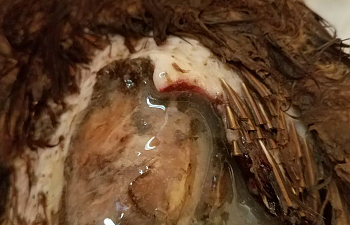
To hasten the healing, I highly recommend "sugar wraps". Sugar for wound healing has been used for centuries, and many veterinarians have adopted the practice. After the wound is clean, and covered with antibiotic ointment, pour sugar over the wound. Granulated table sugar is all you need, and it does not need to be sterilized. Simply pour it over the wound bed, as much as will stick. It will be messy, and very sticky. Afterwards, cover with sterile gauze, and wrap with self adhering first aide wrap (or VetWrap). Skin colored bandages are best, as your chicken is less likely to peck at something if it is not as noticeable.
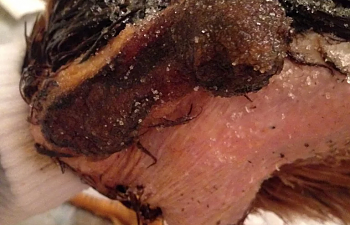
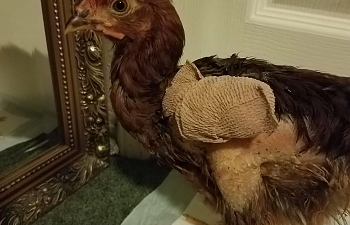
Colored or black vet wrap bothered Raptor- had to switch to something "invisible"
The sugar will increase cellular activity in the wound, which quickens healing. This also means the wound will scab over faster, and has the chance to dry out quicker. You want to prevent the wound from drying out, as a dried out wound is an invitation for nasty bacteria. Remove the dressings, clean, and apply ointment/sugar to the wound bed twice a day. MediHoney wound gel, or any other form of sterile Manuka Honey, has been found to be better than sugar because it does not dry out the wound as quickly, and is less painful during dressing changes. Sugar wraps will often stick the scabs/foreign debris to the gauze, which effectively debrides and cleans the wound, but can be painful. Examples of successful, miraculously sugar wrap stories are below.
If your patient has a "skin pocket" or area where the skin is still mostly attached, but lifted away from the body, (ie a shank or claw tore underneath the skin and it is still attached) clean THOROUGHLY inside the pocket. Use a flashlight to look inside the wound, and spray the antiseptic solution of choice inside to clear out all debris. After cleaning, fill the pocket with neosporin/triple antibiotic ointment/medihoney, and bandage with sterile gauze, then self-adhesive vet wrap. Sugar treatments in pockets are also highly effective; after putting ointment in the pocket, use a qtip to coat the inside with sugar, or simply pour sugar into the wound if you are able. For three days, once a day, clean inside the pocket, and reapply ointment/sugar. After three days, only apply ointment to the outside of the pocket, or at the pocket entrance. The skin will reattach and the pocket will eventually heal itself back together; no stitches or super glue required.
As stated earlier, birds with head injuries are likely to have seizures or shake. It's a natural response, and many birds recover miraculously even after terrible head trauma. Sav-a-chick or electrolyte water replenisher for birds will help with the seizures, and will also help them recover sooner. Putting droplets of the water/electrolyte mix on the corner of your birds beak will help it roll down into their mouth. More than likely your bird is not eating or drinking, so I highly recommend getting something similar to sav-a-chick to encourage your chicken to keep hydrated. Substitutions for sav-a-chick can be plain pedialyte, powerade, or gatorade, diluted 50/50 with water, until they seem to be out of the woods.
Keep your bird in a "hospital" or quarantine area until the wound has healed. If you don't have the space or are unable to quarantine, you can make a "sweater" out of stockinette. Directions on how to do so are linked below; basically, cut holes in a tube for the wings and feet, and slide it on over the chicken's head. You may be able to do something similar with stockings, leggings, or a long sleeved shirt (cut off the sleeve), and cut the tube to fit. With the jacket on, other birds will be unable to harm his/her injuries, and the bandages are far less likely to fall off. My hen Duchess would dust bathe almost every day she wore her stockinette-jacket, and her wound never got dirty.
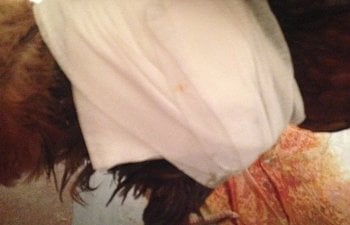
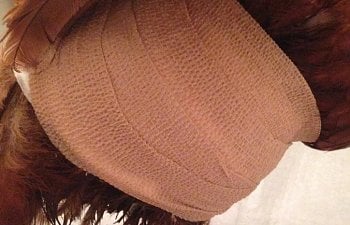
Depending on the wound, it could take a few weeks to a few months to heal. If cleaned properly, the wound should not have a foul order, swelling, or pus. Black, green, or very dark colored tissue that is soft, squishy, and smells terrible signifies necrotic tissue or infection- go to a vet immediately. A good, clean wound will be pink, which is the color of healthy tissue. After the pink scabs over, it will be rough and very dark in color. The scabs will be naturally debrided/removed by the sugar (or honey) after a few days; without sugar or honey, the process will take a little longer, possibly a week before the first scabs come off (and that is only the first stage of healing!). For the first week, clean and apply ointment twice a day (keep it moist), and redress with gauze/sugar (or honey). After the first week, if there are no signs of infection, usually a once a day session is enough; but that is entirely up to you, and how involved the wound is.
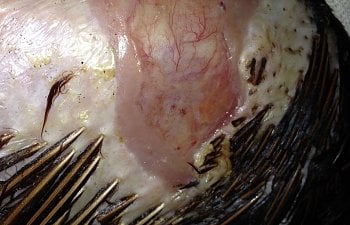
Duchess- after 1week of sugar wraps, and 1week of MediHoney
Above all, when in doubt, ask! You have definitely come to the right community if you have a chicken in trouble. The Forum for Emergencies/Injuries/Disease/Cures is where you should be, if you haven't already! This is by far not an extensive cure-all; but I do hope it can help you get started on treating your chicken's wounds. Good luck in your chicken adventures, and welcome to BYC!
References/Helpful Info:
-Stockinette and Medihoney can both be found on Amazon.com-
-Foot/Toe Problems, Look here ->Leg, Foot and Toe Issues in Poultry of All Ages: https://www.backyardchickens.com/articles/leg-foot-and-toe-issues-in-poultry-of-all-ages.68093/
FlyingNunFarm's Sugar Success Story: https://www.backyardchickens.com/threads/yikes-large-wound-on-hen.1141144/#post-17736677
Raptorchick's Sugar/Honey Success Story: https://www.backyardchickens.com/threads/graphic-pics-wing-amputation-advise.1246736/
ReallyACL's Medihoney Success: https://www.backyardchickens.com/th...njury-2nd-of-june-it-looks-wonderful.1249640/
Treating Wounds and Injuries with Stockholm Hoof Tar: https://www.backyardchickens.com/ar...s-and-injuries-with-stockholm-hoof-tar.74400/
First Aide Kit: https://www.backyardchickens.com/ar...essential-supplies-and-how-to-use-them.64830/
Home Amputation Success Story and How-To: https://www.backyardchickens.com/th...ccess-story-and-how-to.1105559/#post-17008966
Debunking Myths of Wound Care: https://advancedtissue.com/2014/07/debunking-myths-wound-care/
How to Use Sugar to Heal Wounds: https://www.livestrong.com/article/96076-use-sugar-heal-wounds/
Honey vs Sugar in Wound Care: https://www.ncbi.nlm.nih.gov/pubmed/17708384
